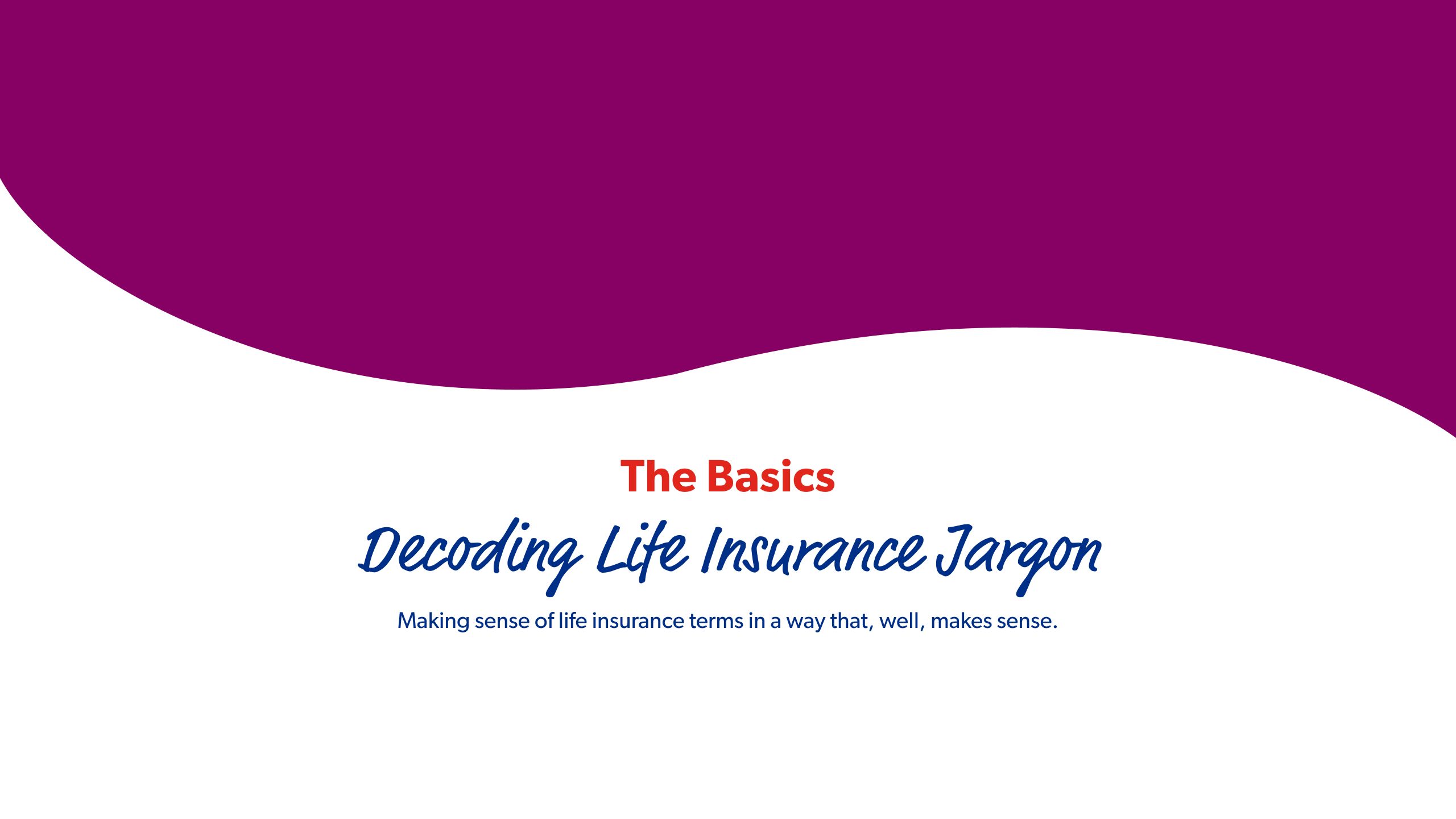
Perhaps the first question that comes to mind for most people about life insurance is, “What is life insurance, exactly?” followed shortly after by, “Do I really need it?”
There’s no one-size-fits-all answer to either of those questions, but a good place to start when answering them for yourself is right here in this comprehensive guide. Starting from the basics, you’ll get to know life insurance from its foundation — learning its terms and jargon plus what to know if it’s your first time purchasing a policy, all the way up to which life events could incur changes to your policy.
There’s a lot to know, but it’s not as intimidating as it seems.
If you still have more questions, AAA insurance agents are available to help.

Annuity: An annuity is a contract that provides you with regular income for life (or a set time period) and is paid out by your insurance policy.
Beneficiary: A beneficiary is the person (or people) you designate to receive compensation if something happens to you.
Cash Surrender Value: Cash surrender value is the amount of money you would get if you canceled your policy before it pays
out — typically minus fees and loans.
Direct Response: Direct response is a type of insurance with no middleman. It’s sold straight to you via mail, online or in person.
Dividend: A dividend is a little bonus you may get back if your life insurance company overcharged for your policy.
Face Amount: Think of face amount like face value: It’s the payment amount on your policy that doesn’t include any extras.
Insurable Interest: Insurable interest is the reason for insuring someone, like personal relationships, family or financial ties.
Insurer vs. Insured: The insurer is the company that provides the policy, and the insured is you (or the person covered).
Lapse: When a policy becomes inactive because premium payments haven’t been made.
Life Insurance: A policy that acts as a financial safety net for your loved ones if anything happens to you. It’s like saying, “I got your back — even if I’m not around.”
Non-forfeiture: Non-forfeiture means that if you stop paying your premiums you won’t lose everything; you can instead choose options like taking cash or reduced coverage.
Participating and Non-participating Policies: A participating policy type may offer a piece of an insurance company’s profits as a dividend. A non-participating policy does not.
Policy Proceeds: Policy proceeds are the funds your policy pays out when it matures, or when someone claims it (i.e. your beneficiary).
Premium: The regular payment that’s made to keep your policy active. It’s sort of like a gym membership, but instead of working out, it’s ensuring your loved ones are financially healthy.
Rating: A rating is an extra charge added to your premium if you are considered a higher-than-average risk.
Rider: Just like how celebrities can add expensive coconut water to their dressing room riders, a life insurance rider is a little add-on to customize your policy (like extra coverage or specific inclusions).
Standard Risk: The classification of a person applying for life insurance coverage; falls under the average standards on which premium rates are based.
Supplementary Contract: A separate agreement for how the policy payout will be managed (instalments vs. lump sum, etc.).
Underwriting: The process of underwriting is like choosing your fantasy team. Both use “stats” (in this case, medical history and lifestyle habits) to evaluate risk and determine the best outcome (cost and type of coverage).

We know that thinking about life insurance and how to keep your family protected when you are gone can feel like a heavy decision, but it’s an important one. Life insurance can help your loved ones take care of outstanding debt or continue to pay everyday expenses. It can also be used to pay off a mortgage, cover final expenses and pay for costs toward child care formerly provided by a stay-at-home parent. And since policy rates increase as you get older, the sooner you can get one in place the better.
Let’s delve deeper into the difference between term vs. whole life insurance and which one best fits your needs.
Term Life Insurance
As the name implies, this type of plan is temporary, offering a fixed premium that provides coverage for a predetermined period of time. Typically, the longest a term plan will extend is 30 years from the issued date, and if the insured dies before the policy expires, the designated beneficiaries will receive the death benefit. Because it offers a more limited scope of protection, term life insurance policies are often more affordable than whole plans.
Whole Life Insurance
Whole plans tend to cost more than term plans. And unlike term plans, a whole life insurance policy is a lifelong commitment. Coverage remains active for the policyholder from purchase until death, and accordingly, the benefits are available at anytime. In addition, whole plans have an intrinsic cash value, and policyholders can often borrow money against them.
What to Consider
Deciding between a term vs. whole life insurance policy depends on your situation.
A term life policy may be the best option in cases where the loss of a loved one could have a profound financial impact on family members. It basically serves as an income replacement designed to protect your dependents and help them maintain their lifestyle if you die during the policy period.
Whole life insurance is preferable for planning your inheritance and your estate’s future. When the time comes, this type of plan will be far better suited to cover estate taxes.
Decisions, Decisions
Whether you go with a term or a whole policy, all plans take into account your age, health and financial standing (i.e., debts, expenses and assets). You should also anticipate any expenses that may arise for your beneficiaries in the coming years, such as education and housing. These are all major factors in making any policy decisions. In the end, the most accurate way to determine which plan fits your budget and expected needs is to compare the long-term costs of all your options.

Why You Need It
Everyone’s financial and familial situation is unique, so the reason why someone needs life insurance is likely different from why you need it. This is why it’s important to take stock of your own circumstances to make the best policy decision for you.
Life insurance is useful for folks of all ages and family types. Even if you are young and healthy, an unexpected accident or illness could occur, and life insurance can keep things stable for those who depend on you. For older adults or those with families, life insurance helps make sure your loved ones aren’t left with a financial burden after you’re gone.
In short, life insurance equals peace of mind.
Goldilocks Your Coverage
Find the coverage that fits your lifestyle — not too much, not too little.
When comparing quotes, pay close attention to the details of each policy, as even the cheapest option may end up costing you later. If the policy doesn’t provide the right amount of coverage for the right amount of time, you may end up paying more down the line.
Shop For the Best Price
One of the most crucial parts of buying life insurance for the first time is shopping for coverage. Look for a policy that suits your needs and your budget.
Premiums, or the amount you pay to keep your policy active, can vary significantly from one insurance provider to another, even for the same coverage. This is why it’s always in your best interest to get quotes from multiple insurers to compare rates and find the best deal.
If you are purchasing life insurance for the first time at a young age, premiums will be cheaper for a higher amount of coverage, so it’s best to lock in those rates now rather than wait until you are older.
Get To Know the Lingo
Before committing to a policy, it’s important that you fully understand the terms and conditions. This might be easier said than done, as insurance jargon can sound like its own other language. Luckily, it’s a lot easier to get the gist once you know the basic terms.
Work With a Reliable Provider
When you purchase your first life insurance policy, you want to go with someone who’s got your back. Choose a reputable insurance company with a strong financial track record and high ratings from independent agencies.
AAA offers life insurance with our members in mind, serving over 1.7 million policyholders with the same excellence you’ve come to expect.

Do
✔ Assess your needs and goals.
Before purchasing life insurance, evaluate your financial needs and long-term goals. Consider factors such as your family’s lifestyle, outstanding debts and future expenses like education and mortgages. Understanding your financial situation will help you determine the appropriate coverage amount.
✔ Regularly review and update your policy.
Life is dynamic, and your financial situation may change over time. It’s a good practice to regularly review your life insurance policy and make changes accordingly that align with your current needs. Major life events such as marriage, the birth of a child or a significant career change may warrant adjustments to your coverage.
✔ Choose the right type of policy.
Life insurance comes in various forms, including term life, whole life and universal life. Each type has its advantages and disadvantages depending on your individual circumstances. Assess your needs and preferences to choose the policy that best fits your financial objectives.
✔ Disclose all relevant information.
Honesty is key when applying for life insurance. Provide accurate and complete information about your health, lifestyle and medical history, as failing to disclose relevant details can lead to complications during the claims process — potentially resulting in the denial of benefits.
✔ Consult with a professional.
Speaking to an insurance professional will allow you to receive personalized advice and get a better understanding of your options. They can also give expert guidance on policy features and comparisons.
✔ Stay vigilant.
Life insurance scams happen every day, and becoming a victim can be costly and life-changing. If you are in the process of taking out a life insurance policy, updating an existing policy or have been contacted about an existing or new policy, do your research to understand these scams and avoid becoming a victim.
Don't
✘ Assume it’s too early to think about life insurance.
Procrastination can be detrimental when it comes to life insurance. “No one has a crystal ball and can predict what lies ahead for themselves or people they care about,” advised Chris Perrier, life and annuity insurance manager with AAA Northeast. The younger and healthier you are when you purchase a policy, the lower your premiums are likely to be. Waiting until later in life can result in higher costs and potential health issues that may affect your insurability.
✘ Underestimate your coverage needs.
It’s important to adequately estimate your coverage needs to ensure your loved ones are financially secure in the event of your death. Underestimating the amount can leave your family vulnerable to financial strain.
✘ Lapse payments.
Failing to pay your life insurance premiums can lead to a lapse in coverage. If this happens, you may lose the benefits you’ve been paying for. Set up automatic payments or reminders to make sure you stay current on your premiums and maintain continuous coverage.
✘ Rely solely on employer coverage.
While employer-sponsored life insurance is a valuable benefit, it may not be sufficient for your needs. Only having this coverage can leave you underinsured, especially if you experience a change in employment. Consider supplementing employer coverage with an individual policy to provide comprehensive protection.
✘ Overlook policy exclusions and limitations.
Life insurance policies have exclusions and limitations that specify situations where benefits may not be paid. It’s crucial to understand these terms and conditions to avoid surprises during the claims process.
“All too often people put off buying the protection they need, and then a tragedy occurs and it’s too late. Be proactive, explore your options and take action if it’s necessary to do so.”
Chris Perrier, AAA Northeast Director of Life Insurance Sales Operations

Having life insurance is an important part of your long-term financial plan, but there are some circumstances that may necessitate the use of supplemental services — like income annuities.
Not to be confused with life insurance, income annuities are financial products designed to provide a stream of income for a specified period, typically for the duration of a person’s life. Think of them as a long-term financial safety net with a twist. You can either contribute a lump sum or pay into it over time — kind of like a savings plan. In return, you get a steady stream of income immediately or in the future, usually when you retire. It’s sort of like giving yourself a paycheck even when you’re not working anymore, which is particularly valuable for retirees who do not have access to traditional pension plans or who have exhausted other sources of income.
Income annuities come in two varieties — immediate or deferred income. Income annuities offer protection against longevity risk, as well, which is the risk of outliving one’s savings. By providing a guaranteed income for life (or a specified term), annuities ensure that retirees will not run out of money, regardless of how long they live.
How Do Income Annuities Work?
To get the benefits of an income annuity, you must either contribute a lump sum or pay regular premiums to your insurance company. In exchange, you receive the promise of future guaranteed income payments. These future payments are based on various factors, including age, gender, interest rates and the length of the term. When you reach a certain age or retire, the insurance company begins paying you back in regular installments, similar to how social security operates.
There’s a good amount of flexibility when it comes to income annuities, too. It’s up to you how long you’d like to receive payments for — whether it’s for a specific number of years or for life. During this time, you receive regular payments, typically on a monthly or annual basis.
Income annuities bring some tax benefits, too, which is always a bonus when it comes to money matters. While the specifics vary depending on the jurisdiction and the type of annuity, in many cases the income deferred or received from annuities can be designed to maximize tax efficiency.
What Else Is There to Know About Income Annuities?
There are some potential drawbacks and limitations to consider before opening an income annuity.
First, it’s important to remember that most income annuities are not suitable if you anticipate needing your money back in a lump sum or for emergencies in the short term. This means that annuities should be considered in coordination with a full needs analysis — while being mindful of short-term and long-term financial goals.
While they offer stability, some income annuities do not provide payments that keep up with inflation over time, essentially decreasing their initial purchasing power. Some income annuities do provide this feature, so it is important to work with a financial professional that can match your needs with the right solution.

Why It’s Never Too Early to Start Thinking About Life Insurance
Start planning for the future and take advantage of low rates by getting life insurance coverage as soon as possible.
When it comes to purchasing life insurance, the sooner the better. Don’t miss out on the opportunity to build a formidable financial support system.

Why It’s Never Too Early to Start Thinking About Life Insurance
Start planning for the future and take advantage of low rates by getting life insurance coverage as soon as possible.
When it comes to purchasing life insurance, the sooner the better. Don’t miss out on the opportunity to build a formidable financial support system.

Life Insurance Sets Up a Financial Foundation
Contrary to popular belief, you don’t have to be middle-aged or even have started a family for life insurance to be a worthwhile contribution. In fact, establishing a life insurance policy early on could be a smart way to set the tone for your financial future.
For young adults just starting to build their finances, such a policy could be the safety net that makes all the difference. This age group typically has yet to amass significant savings or a retirement plan; life insurance could ensure that a future spouse or children are provided for under any circumstances.
Even if you don’t have anyone depending on you just yet, you’ll be thankful to have gotten a jump-start on investing in your family’s future early on. It’ll put you that much closer to your financial goals later in life.
Early Affordability
One of the clearest reasons why you shouldn’t wait to start a life insurance plan is because of how affordable rates are for young adults. A policy’s cost is affected by a wide range of factors, but your age and general well-being are chief among them. So, beginning a policy when you’re young and healthy means rates are likely as low as they’ll ever be.
Adjustable to Your Needs
Just as the rates for life insurance vary based on your specific situation, you may be relieved to know that there is no one-size-fits-all approach to the kind of policy you can acquire. How much you contribute and how much coverage you attain are up to you. You can customize your policy to your budget and your lifestyle.
Priceless Peace of Mind
More than laying the groundwork for your financial future, your life insurance plan puts in place a support system that will provide for your family long after you’re gone. That’s a peace of mind that cannot be effectively quantified, no matter what your premium is.

It’s easy to believe that the group life insurance offered through your employer is sufficient coverage for you and your family. After all, what’s good for the goose is good for the gander, right? Well, not necessarily.
While group life insurance is generally affordable and convenient, it has its shortcomings. Relying solely on your life insurance through work could mean there isn’t enough to support your family’s needs.
How Group Life Insurance Limits Your Coverage
Employee-provided life insurance only offers a fixed amount of coverage for a specified period of time. The coverage amount is often a multiple of your salary, but doesn’t consider factors such as outstanding debts, mortgage obligations or a variety of future expenses.
Plus, group life coverage isn’t portable. When you leave your job — whether by choice or circumstances beyond your control — your life insurance coverage may end, leaving you and your family without protection during a period when financial stability is needed most.
Another significant drawback of life insurance through work is the lack of customization. These plans are designed to cater to a diverse group of employees, and as a result may not address everyone’s specific needs. Your financial situation, lifestyle, responsibilities and future plans are unique, and a one-size-fits-all approach to life insurance may not be sufficient.
Get the Best of Both Worlds
Should you get life insurance through work? Sure, work life insurance is a valuable benefit, but it shouldn’t be considered a stand-alone solution for comprehensive coverage. Getting a personalized, individual life insurance plan ensures that your unique circumstances are accounted for in addition to being portable and offering the flexibility to adapt to life’s changing stages. You also get to choose whether you’d like a term or permanent policy.
Regular assessments of your coverage and consulting with a life insurance agent can help ensure that your life insurance strategy remains aligned with your evolving needs, providing you and your loved ones with the peace of mind they deserve.

Life Events That Warrant Updates to Your Life Insurance Policy
Big life changes are exciting, but they also require changes to insurance. Don’t forget to make these corresponding adjustments to your life policy.
The happy arrival of a new family member brings joy and responsibilities, including the need for insurance updates. When you have children, it becomes crucial to reassess your life insurance policy to ensure everyone is covered and cared for in the event of an untimely passing.
This may also be an opportune time to discuss term life insurance versus whole and decide which suits your family best considering the new circumstances. While term life insurance is ideal for covering large debts (mortgages, other loans, etc.) for a set period of time, whole life insurance is typically used for estate planning, final expenses and leaving a legacy.
Other life events that require changes to life insurance include:
- Getting married.
- Purchasing a home.
- Job changes.
- Retirement.
- Teen(s) entering college.

Getting married is one of life’s biggest milestones and, consequently, is something that necessitates a lot of important conversations. While choosing your wedding florist is undoubtedly important, we mean something more to the tune of discussing your financial future. In essence, life insurance.
No one wants to imagine the possibility of losing someone they love, but planning for the unexpected is an act of love that can protect both of you for the future.
The Importance of Life Insurance in Marriage
Life insurance isn’t just a policy, much like how your marriage license is more than just a piece of paper. Both are essentially a promise in good faith.
Whether it’s covering debts, protecting your partner’s standard of living or ensuring that your children or future dependents are taken care of, life insurance plays a vital role in providing peace of mind. In the event of an untimely passing, having life insurance can ease the financial burden that might otherwise fall on you or your partner. It can make sure they’re not left to manage things like funeral costs, mortgages, student loans or other financial obligations.
Discussing Life Insurance With Your Partner
Before you even consider the specifics of a policy, it’s important to sit down and have an honest conversation about life insurance with your partner. Although it will likely feel uncomfortable or emotional, it’s crucial to approach the discussion from a place of care and responsibility.
Start Early
Don’t wait until you have children or your financial situation becomes more complex before you start talking about life insurance. The earlier you start, the more options you’ll have and the easier it’ll be to secure affordable coverage. Starting early means locking in lower premiums and giving yourselves time to adjust coverage as your needs evolve.
Be Transparent
Make sure you discuss your financial goals, debts and income. This will give both of you a clearer picture of how much life insurance you’ll need. Whether you’re paying back student loans, a mortgage or are considering family planning, being clear about your financial obligations will ensure your policy covers all the necessary expenses.
Talk About Your Needs
There are various types of life insurance, such as term life, whole life and universal life, each with different benefits. Make sure you understand the differences and discuss which type of coverage fits your lifestyle and goals.
Consider Each Other’s Opinions
It’s always important to listen to your partner’s concerns and desires — especially when it comes to life insurance. It’s a shared responsibility; understanding what matters most to each other will help in choosing the right coverage and beneficiary designations.
How to Provide a Financially Secure Start to Your Marriage
Happy finances, happy life? We say so! By setting yourself and your partner up for success early on, you can focus on your future together without being burdened by financial stress.
To start, establish a clear and realistic budget before making any big financial decisions. Determine how much you each earn, what your regular expenses are and where you can save. This can help you both feel aligned with financial goals and prevent future misunderstandings.
If either or both partners come into the marriage with debt — credit card, student loans, car loans, etc. — it’s important to address it head-on. Consider taking out life insurance to cover any large debts that would otherwise fall to your partner in the event of your passing.
Life insurance isn’t the most romantic topic to discuss, but it is one of the most practical ways to ensure your loved one’s well-being in the event of the unexpected. By encouraging open conversations and planning for a secure future together, you can start your happily ever after worry-free.

Lots of life events can necessitate a change to your life insurance policy, but in particular, having a child could certainly be considered one of the biggest. It’s also the sort of life event that comes with lots of questions, especially if it’s your first child. So, when it comes to deciding whether or not to purchase a child a life insurance policy, you may be wondering what it all means and whether it will be worth it in the long run.
What is life insurance for children?
Just like life insurance for an adult, life insurance for children is an agreement with an insurance company — but in the case of a child aged 17 or younger, a parent, grandparent or guardian serves as the policyholder.
Child life insurance policies are put together in hopes that the growth that occurs will result in a considerable amount of usable equity to aid in providing substantial living benefits.
What are the benefits of a child life insurance policy?
One of the biggest advantages of child life insurance is the feeling of security in knowing that your child is financially prepared for life’s big moments. Children’s life insurance policies provide continuing coverage as they grow older for things like starting a family or getting married — where the coverage can then provide that much more value to families of their own.
Having a policy also guarantees your child will have coverage in the event they end up developing a health condition later on in life. In addition, you’re locking in a low rate.
A huge benefit of these policies is that when children are young and healthy, the cost of insurance is as low as it will ever be. There is no better time to secure a policy to ensure they will always have coverage in place in the event they become uninsurable.
Child life insurance policies can either be purchased separately from a parent or guardian’s policy, or they can be added as a term rider. Typical life insurance policies for children are categorized as either whole life or indexed universal life.
What is indexed universal life insurance?
An indexed universal life policy, offers permanent lifetime protection and the ability to grow in a stock market to increase the interest that’s credited to the cash value in the policy. The beauty of this policy is that no dollars are actually invested in the index. In the event that the market has a down year, there would be no loss of any cash value.
This kind of policy also has what is referred to as an annual reset, so any gains obtained are locked in every year they occur. This way, there’s never a risk of loss but always a healthy potential for growth. A monthly investment of as little as $50 can result in a huge potential for cash value growth while the child grows up. That cash value could be easily used for college, a down payment on a home, opening a business or any number of life’s big events.
Can you purchase a policy for your grandchildren?
Grandparents are welcome to purchase a policy for their grandchildren. Many folks establish child policies for their grandchildren as a gift when the child is born. While most children outgrow tangible gifts such as toys or clothing, a children’s life insurance policy can be designed to create a lasting legacy for generations to come.
Request a life insurance quote or connect with a AAA life insurance advisor to learn more.

Request a life insurance quote or connect with a AAA life insurance advisor to learn more.








